Physical Address
304 North Cardinal St.
Dorchester Center, MA 02124
This chapter will review both superficial and deep forms of folliculitis as well as disorders of follicular keratinization and the follicular occlusion tetrad (acne conglobata, hidradenitis suppurativa, dissecting cellulitis, and pilonidal sinus). Examples of superficial folliculitis include those due to Staphylococcus aureus or Pseudomonas aeruginosa infections, whereas acne keloidalis and pseudofolliculitis barbae are examples of deep forms. The disorders of follicular keratinization represent a varied group of dermatoses that have in common prominent keratotic follicular plugs. Some of these disorders are reviewed in other chapters, e.g. lichen planopilaris, pityriasis rubra pilaris (PRP) and keratosis pilaris, while others are discussed here, e.g. lichen spinulosus and erythromelanosis follicularis faciei. Lastly, there are inflammatory disorders that can have a follicular predilection such as GVHD or, in darkly pigmented skin, papular eczema and pityriasis rosea.
▪ Impetigo of Bockhart
Follicular pustules, often arising on an erythematous base
Favors areas with terminal hairs, such as the scalp and beard, as well as the upper trunk, buttocks, and lower extremities
Bacterial culture of pustular contents most commonly reveals normal flora, followed by Staphylococcus aureus
Treatment depends on the particular type of folliculitis
Folliculitis is a very common disorder characterized by follicular pustules. It can be secondary to a wide range of infectious agents, or be induced by irritants or drugs ( Fig. 38.1 ). Microbial cultures may fail to identify a pathogen, but, of the infectious etiologies, Staphylococcus aureus is the most common.
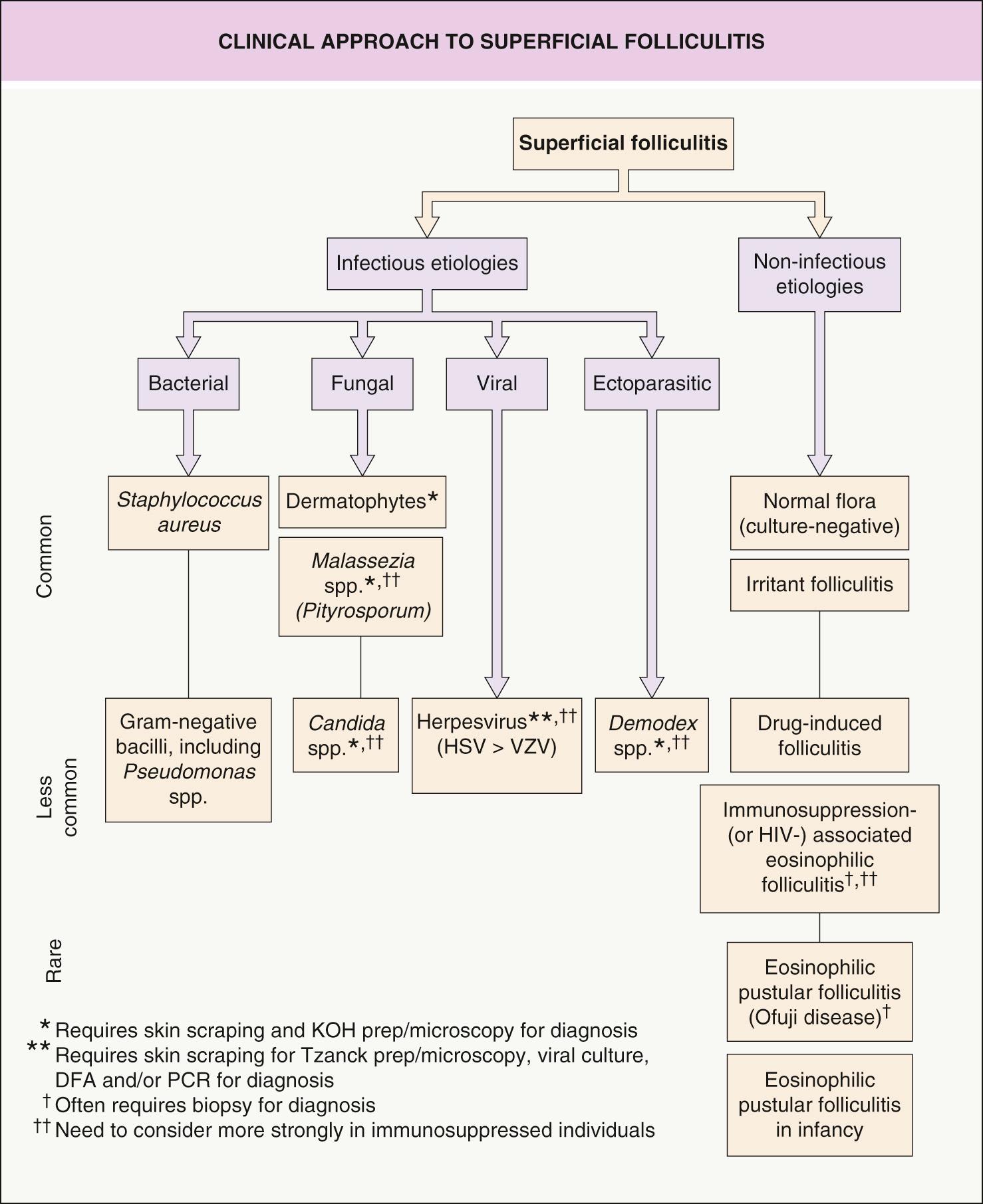
Follicular pustules are usually accompanied by an erythematous rim ( Fig. 38.2 ). If no pustules are present, follicular-based erythematous papules or a superimposed collarette of scale serve as clues to the diagnosis. Lesions may be pruritic or even tender or painful. Occasionally, when there is more widespread involvement, patients will complain of generalized pruritus .
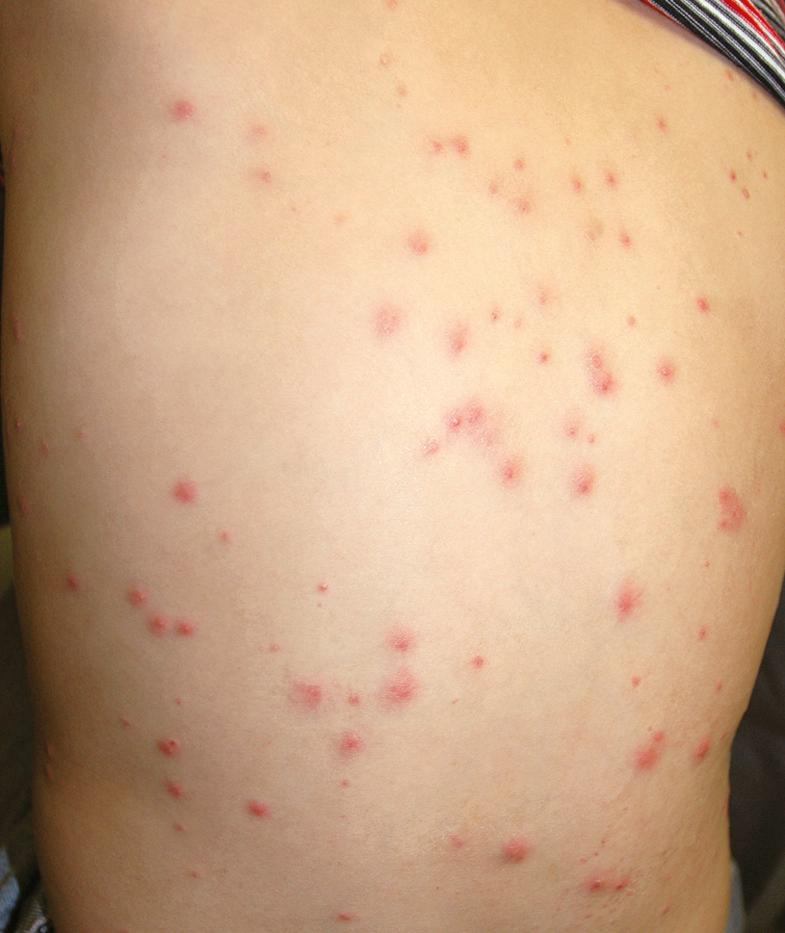
Folliculitis occurs most commonly in the head and neck region (especially the scalp and beard area), upper trunk, buttocks and legs, as well as in the axillae and groin ( Fig. 38.3 ). It favors areas that are occluded and/or have terminal hairs. In addition, shaving, especially against the direction of hair growth, can predispose to folliculitis.
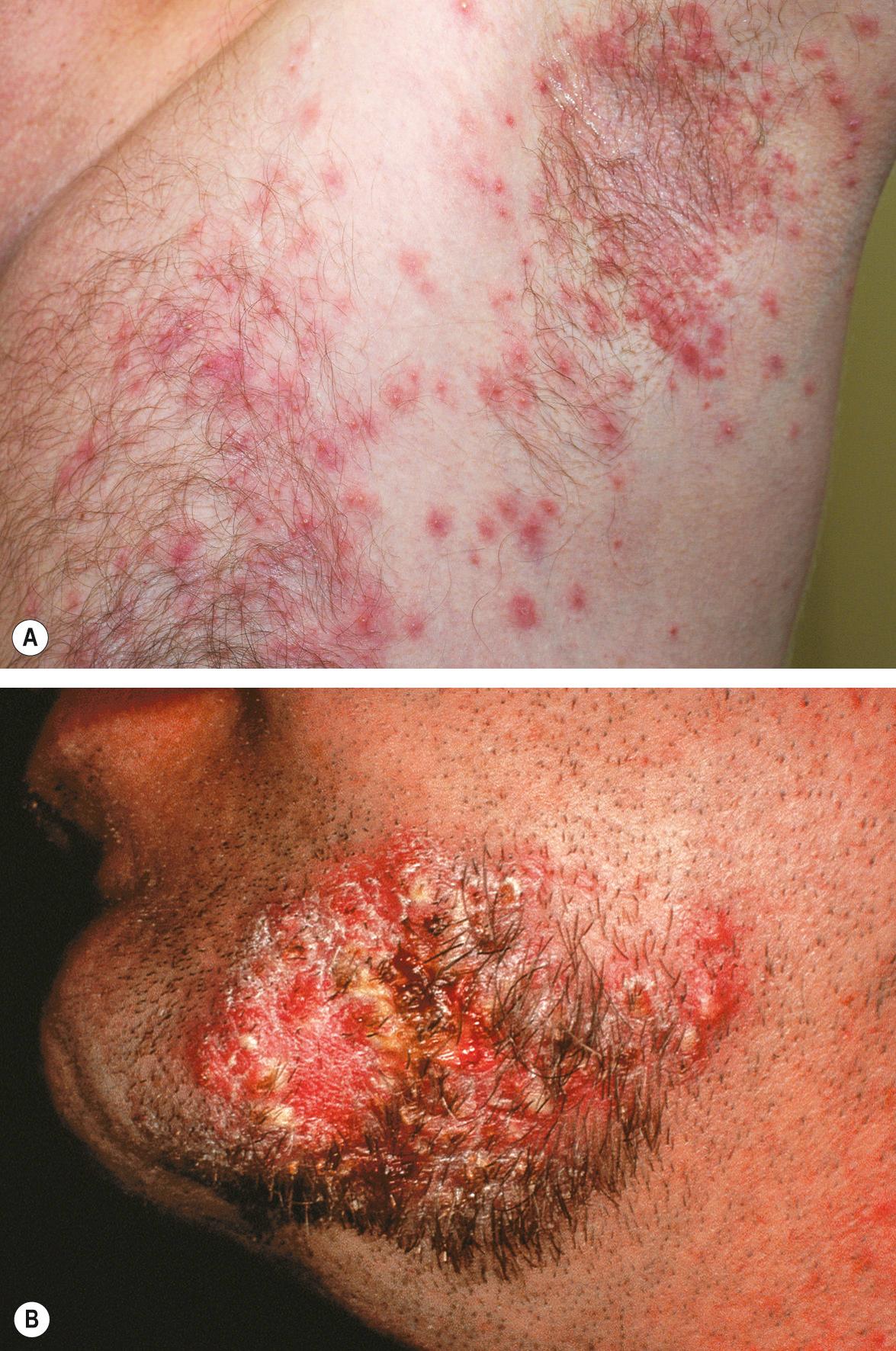
A perifollicular infiltrate of lymphocytes, neutrophils, and macrophages is seen, with extension of the neutrophils into the follicular epithelium and follicular canal aggregating variably to form an abscess. Late-stage changes include follicular rupture and a granulomatous response. Tissue Gram stain may reveal pathogenic organisms. Occasionally, cytopathic changes due to herpes simplex viral infection are seen within the follicular epithelium (see Ch. 80 ) or multiple Demodex organisms are present within the follicular canal in demodicosis (see Fig. 38.5C ), leading to the diagnosis of other forms of folliculitis.
In addition to the various forms of folliculitis listed in Table 38.1 , the differential diagnosis also includes acne vulgaris, pseudofolliculitis barbae and, occasionally, rosacea. Microscopic examination of follicular contents may provide a clue to the type of folliculitis as can microbial cultures and histologic examination. In patients who are confined to bed, folliculitis may develop predominantly on the posterior trunk and thus needs to be distinguished from other disorders exacerbated by occlusion including Grover disease, miliaria rubra, and cutaneous candidiasis.
| LESS COMMON SPECIFIC FORMS OF FOLLICULITIS | ||
|---|---|---|
| Etiology/risk factors | Clinical features | Therapy |
| Irritant folliculitis | ||
| Usually occurs following the application of topical medications (e.g. tar preparations), ointments Exacerbated by application in a direction opposite that of hair growth |
|
|
| Gram-negative folliculitis | ||
| Due primarily to Klebsiella, Escherichia coli, Enterobacter and Proteus spp. Usually seen in patients with acne vulgaris receiving long-term antibiotic therapy |
|
|
| Hot tub folliculitis due to Pseudomonas aeruginosa in the setting of use of a hot tub/whirlpool 12–48 hours prior to onset |
|
|
| Dermatophyte folliculitis | ||
| Tinea barbae usually due to Trichophyton mentagrophytes or T. verrucosum Classically occurs in male farm workers |
|
|
| Majocchi granuloma, usually due to T. rubrum , characteristically develops in women who shave their legs Additional risk factors include occlusion, immunosuppression, and use of potent topical corticosteroids |
|
|
| Malassezia (Pityrosporum) folliculitis | ||
| Typically occurs in young adults, with aggravating factors including warm weather, occlusion and excessive sebum production May also develop in association with antibiotic therapy (especially tetracyclines) or iatrogenic immunosuppression (e.g. organ transplant recipients) |
|
|
| Candida folliculitis | ||
| Primarily in diabetics |
|
|
| Herpes simplex folliculitis | ||
| Herpetic sycosis is usually seen in men with a history of recurrent localized facial herpes simplex infection who shave with a blade razor Widespread or unusual presentations of herpes simplex folliculitis may be seen in HIV-infected or otherwise immunosuppressed individuals |
|
|
| Demodex folliculitis (demodicosis) | ||
| May be associated with immune suppression |
|
|
| Drug-induced folliculitis (acneiform eruption) | ||
| Most common in acne-prone patients and age groups Corticosteroids, androgenic hormones, EGFR inhibitors, MEK inhibitors, sirolimus, iodides, bromides, lithium, isoniazid, and anticonvulsants Can develop within 2 weeks of starting the offending agent, but the risk is often proportional to the dose and duration of therapy |
|
|
| Necrotizing infundibular crystalline folliculitis | ||
| Yeasts and Gram-positive bacteria in affected follicles |
|
|
| Actinic folliculitis | ||
| Seasonal Follows initial summer sun exposure |
|
|
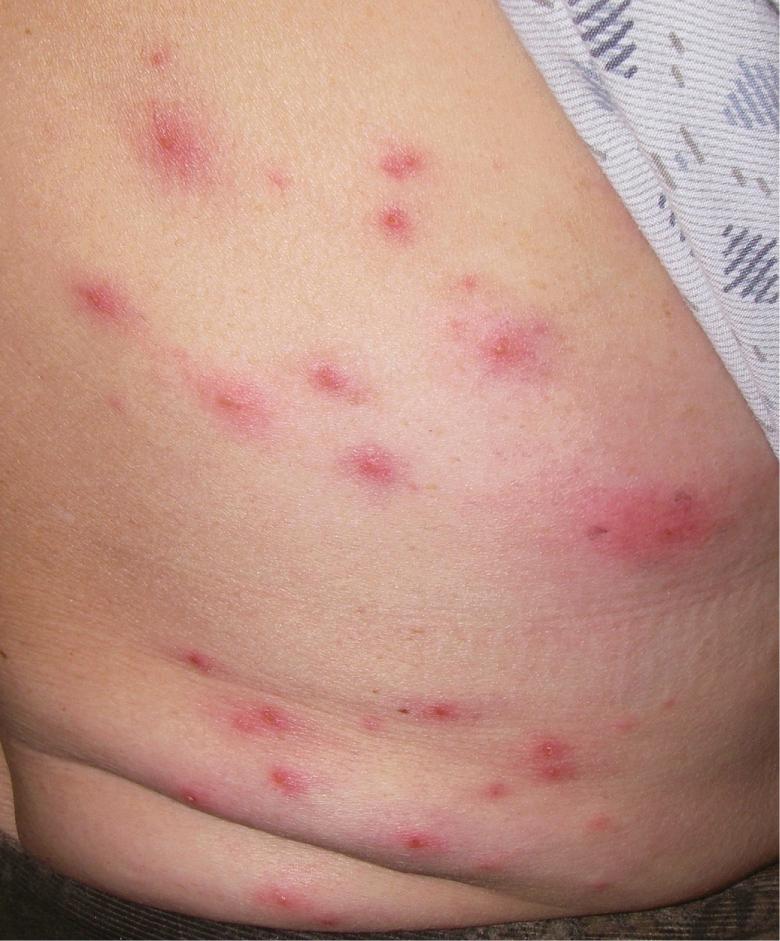
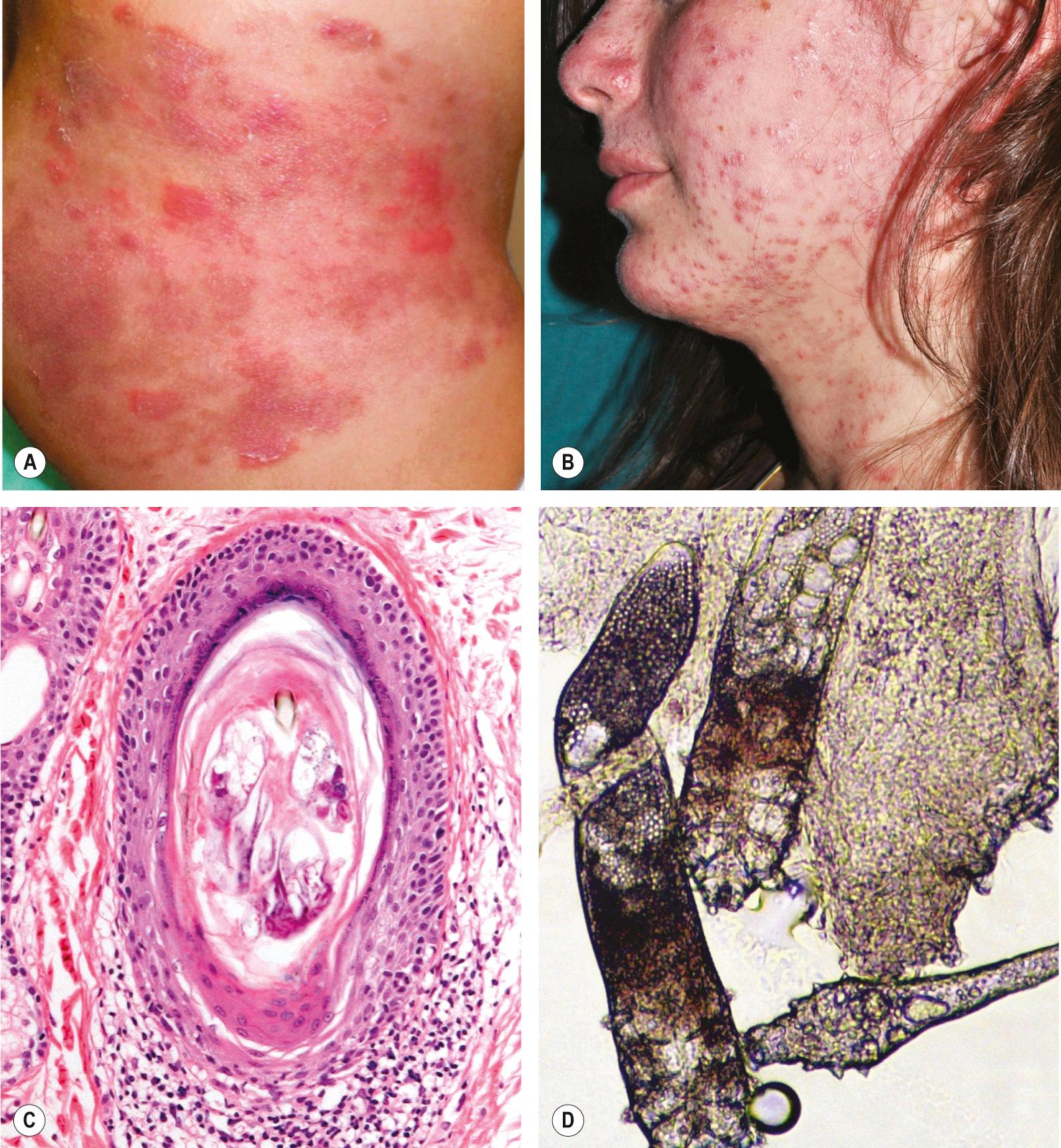
The treatment chosen depends upon the culture results and severity (see Chs 74 & 127 ). For patients whose cultures fail to demonstrate a pathogenic microbe, the treatments, as in acne, include topical benzoyl peroxide, topical antibiotics (e.g. clindamycin), and oral antibiotics (e.g. tetracycline, doxycycline), with the anti-inflammatory properties of these antibiotics probably playing a role. This should be combined with measures to reduce overhydration of the skin, occlusion, and irritation.
Three major forms of eosinophilic folliculitis have been described – eosinophilic pustular folliculitis (Ofuji disease), immunosuppression (or HIV)-associated eosinophilic pustular folliculitis, and eosinophilic pustular folliculitis of infancy.
▪ Ofuji disease
Follicular papulopustules as well as erythematous patches and plaques with superimposed coalescent pustules; central clearing leads to figurate lesions
Most commonly involves the face, followed by the upper extremities and trunk
Moderate to severe pruritus is a frequent symptom
Recurrent crops of lesions that involute over 7–10 days
Peripheral blood eosinophilia is also seen
Histologically, eosinophils predominate around and within the follicular epithelium
Eosinophilic pustular folliculitis is characterized by recurrent episodes of eruptive, intensely pruritic, follicular papulopustules. It typically affects “acne-prone” areas of the body such as the face, back, and extensor surface of the arms . To date, this disorder has not been associated with systemic disease.
In 1965, Ise and Ofuji were the first to report a patient who had repeated episodes of follicular pustules on the face and back with peripheral blood eosinophilia. Five years later, Ofuji et al. described three additional patients and proposed the name “eosinophilic pustular folliculitis” for this new clinical entity. Of note, this is not to be confused with papuloerythroderma of Ofuji (see Ch. 25 ).
Eosinophilic pustular folliculitis is a relatively rare entity, with most of the cases reported from Japan. The majority of patients are adults and the average age of onset is 30 years. The ratio of men to women is ~5 : 1 amongst Japanese patients. There have been occasional reports of eosinophilic pustular folliculitis in children, often with clinical features similar to the infantile form (see below).
The etiology and pathogenesis of eosinophilic pustular folliculitis is unknown. Proposed mechanisms include hypersensitivity reactions to various antigenic stimuli (e.g. infectious agents, medications) and immune dysfunction .
Recurrent crops of intensely pruritic, grouped, follicular pustules and papulopustules develop in a somewhat explosive fashion. In addition, there may be erythematous patches and plaques with superimposed coalescent pustules; central clearing and centrifugal extension produce annular and figurate lesions. Typically, areas with “sebaceous” follicles, such as the face, back, and extensor surface of the arms, are affected. However, the digits, palms and soles may be involved, proving that not all lesions are follicular. Lesions last ~7–10 days and tend to relapse every 3–4 weeks. The patients have no accompanying systemic symptoms.
Involved follicles may show spongiosis, with exocytosis of lymphocytes and eosinophils into the follicular epithelium. These findings can extend from the sebaceous gland and its duct up to and including the infundibular zone. A dermal infiltrate of lymphocytes and eosinophils may also be present. Micropustular aggregation develops, followed by the hallmark finding of infundibular eosinophilic pustules . Secondary follicular mucinosis is sometimes seen.
Clinically, some of the lesions may resemble other forms of superficial folliculitis (see previous section). However, the explosive crops, annular plaques with central clearing, intense pruritus, peripheral blood eosinophilia, and histologic findings typically enable differentiation from clinically similar entities. Rarely, early eosinophilic pustular folliculitis may have a symmetric, butterfly rash-like presentation that resembles acute cutaneous lupus erythematosus.
To date, potential treatments are based upon case reports or small series. Topical corticosteroids, tacrolimus ointment, and oral antihistamines can be prescribed for the associated pruritus. First-line treatment for eosinophilic pustular folliculitis is oral indomethacin (50 mg/day). Second-line therapies include UVB phototherapy, oral minocycline (100 mg twice daily), oral dapsone (100 to 200 mg/day for ≥2 weeks), systemic corticosteroids, and colchicine (0.6 mg twice daily). Cyclosporine may be considered in patients with refractory disease.
▪ AIDS-associated eosinophilic folliculitis ▪ HIV-associated eosinophilic folliculitis ▪ Immunosuppression-associated eosinophilic folliculitis
Markedly pruritic follicular papules, urticarial and/or pustular, that favor the face, scalp, and upper trunk
Occurs in the setting of immunosuppression, including from HIV infection and following allogeneic hematopoietic stem cell transplantation
In HIV-infected patients, the CD4 count is usually <200 cells/mm 3 ; it may also be a manifestation of IRIS (immune reconstitution inflammatory syndrome)
Histologically, lesions are characterized by spongiosis and exocytosis of eosinophils and lymphocytes into the follicular epithelium
A pruritic papular eruption with histologic features similar to eosinophilic pustular folliculitis (Ofuji disease) was originally described in HIV-infected patients, many of whom fulfilled the criteria for AIDS. Eosinophilic folliculitis has subsequently been observed in patients with lymphoma, chronic lymphocytic leukemia, acute myelogenous leukemia and other myeloproliferative disorders, as well as in those who have undergone allogeneic hematopoietic stem cell transplantation; hence, the use of the term immunosuppression-associated eosinophilic pustular folliculitis . However, in contrast to Ofuji disease, there are neither large coalescent pustules nor figurate lesions and the individual lesions are more persistent.
Although the early descriptions of HIV-associated eosinophilic folliculitis were in men, it can also occur in women . Its development correlates with a low CD4 count (in particular <200/mm 3 ), and clinical improvement has been observed as the CD4 count rises due to antiretroviral therapy (ART). However, there are instances where eosinophilic folliculitis develops within 3 to 6 months of initiating ART, implying an association with the immune reconstitution inflammatory syndrome (IRIS; see Ch. 78 ).
Little is known about the exact pathogenesis of immunosuppression-associated eosinophilic folliculitis. However, as in other eosinophilic diseases, a Th2 immune response has been implicated. In patients with AIDS, elevated levels of interleukin (IL)-4, IL-5, RANTES (CCL5), and eotaxin (CCL11) mRNA were detected within lesional skin (see Ch. 25 ) . A more recent study found elevated serum levels of three additional chemokines, CCL17, CCL26 (eotaxin-3) and CCL27, in patients with HIV-associated eosinophilic folliculitis .
Immunosuppression-associated eosinophilic folliculitis is characterized by a chronic, pruritic, follicular papular eruption of the face, scalp, and upper trunk ( Fig. 38.6A ). The papules are often slightly edematous and pustules may or may not be present ( Fig. 38.6B ). The associated pruritus is often intense. Some patients may also have lymphopenia.
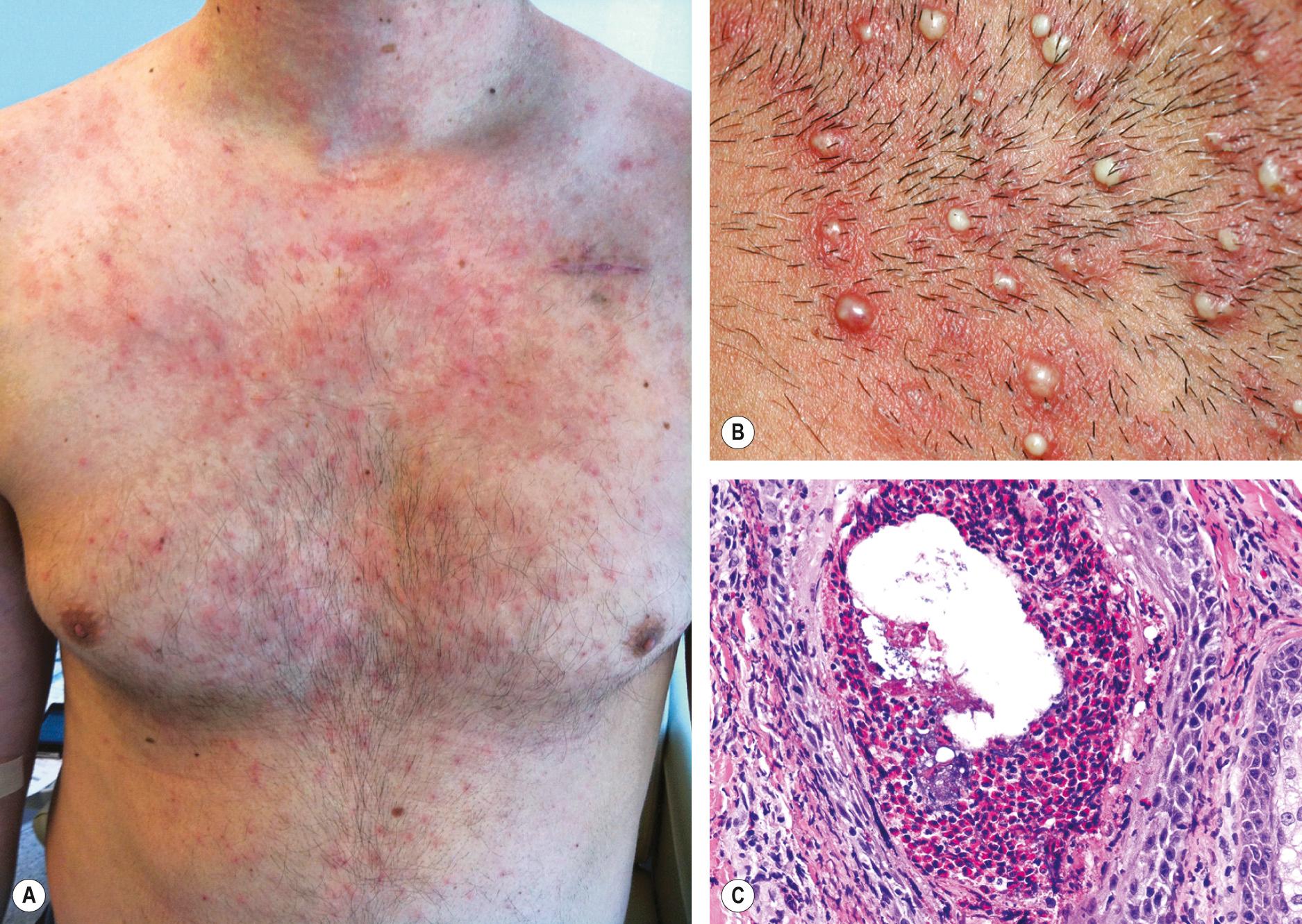
The histologic features are similar to those of Ofuji disease (see above; Fig. 38.6C ) .
The differential diagnosis includes more common causes of folliculitis (see above) as well as the entities outlined in Table 38.1 , especially Demodex folliculitis. Microscopic examination of follicular contents as well as performance of a biopsy may be necessary to establish the diagnosis (see Fig. 38.1 ). Additional disorders to consider, especially when there are no pustules and it is uncertain if lesions are follicular-based, are HIV-associated pruritic papular eruption , papular dermatitis, or arthropod bites and other causes of a “dermal hypersensitivity reaction”. The possibility of septic emboli due to an opportunistic infection depends upon the clinical setting. Necrotizing eosinophilic folliculitis is said to be distinguished by its association with atopy and the presence of nodules and ulceration, with evidence of follicular necrosis and eosinophilic vasculitis histologically.
For HIV-infected patients, treatment of the underlying viral infection, with a resultant rise in the CD4 cell count, may lead to a resolution of lesions. In patients with IRIS-associated exacerbations, the goal is improvement despite continuation of ART as the IRIS-related disease activity gradually subsides. A need for temporary interruption of ART would be unlikely if eosinophilic folliculitis were the primary manifestation of IRIS.
For all patients, oral and topical antipruritics in combination with topical corticosteroids can be tried, but if they prove inadequate, UVB phototherapy may be required. Additional therapies include topical tacrolimus, topical permethrin, oral itraconazole (200–400 mg daily), oral metronidazole (250 mg three times daily), oral antibiotics, isotretinoin (0.5–1 mg/kg/day × 1–4 weeks, then taper), and interferon (β and γ) .
▪ Eosinophilic pustular folliculitis in infancy ▪ Infantile eosinophilic pustular folliculitis ▪ Neonatal eosinophilic pustular folliculitis ▪ Eosinophilic pustular folliculitis in childhood ▪ Eosinophilic pustulosis (of the scalp) in childhood
Unusual, self-limiting disorder that typically appears during early infancy
Multiple, pruritic, follicular pustules and vesiculopustules on an erythematous base
Seen primarily on the scalp and brow region
Secondary crusting is common
Histologically, there is a dense perifollicular infiltrate of eosinophils and lymphocytes, which may spare the sebaceous glands and outer root sheath
Eosinophilic pustular folliculitis of infancy is a rare, self-limiting disorder of unknown etiology that occurs during infancy (see Ch. 34 ). It differs from eosinophilic pustular folliculitis in adults by primarily involving the scalp, frequently developing secondary crusting, and a lack of an annular configuration.
In 1984, Lucky et al. first described five infants with this disorder. To date, one HIV-related case has been reported in an infant, with an onset at 3 months of age .
Become a Clinical Tree membership for Full access and enjoy Unlimited articles
If you are a member. Log in here